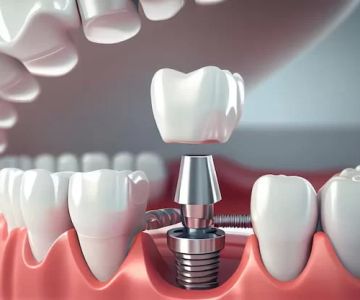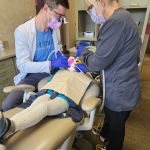The Role of Antibiotics in Treating Gum Disease: A Comprehensive Guide
- 1. Understanding Gum Disease
- 2. The Role of Antibiotics in Treating Gum Disease
- 3. When Are Antibiotics Prescribed for Gum Disease?
- 4. Types of Antibiotics Used for Gum Disease
- 5. Benefits of Using Antibiotics for Gum Disease
- 6. Risks and Side Effects of Antibiotics for Gum Disease
- 7. Real-World Example: Antibiotics and Gum Disease
- 8. When to Seek Dental Care
- 9. Conclusion
1. Understanding Gum Disease
Gum disease, also known as periodontal disease, is an infection of the tissues that surround and support the teeth. It’s caused by the buildup of plaque on the teeth, leading to inflammation and infection of the gums. If left untreated, gum disease can progress and cause tooth loss. Early stages of gum disease are typically treatable with good oral hygiene, but more severe cases may require professional treatment, including the use of antibiotics.
2. The Role of Antibiotics in Treating Gum Disease
Antibiotics play a crucial role in treating gum disease, especially when the infection has spread beyond the gums and into the deeper tissues. They are typically prescribed alongside other treatments such as scaling and root planing to reduce the bacterial load and prevent further damage to the gums and bone. Antibiotics help to control the infection, reduce inflammation, and promote healing of the gums.
3. When Are Antibiotics Prescribed for Gum Disease?
Antibiotics are generally prescribed when gum disease has reached a moderate to severe stage. In these cases, scaling and root planing alone may not be enough to eliminate the bacteria that are causing the infection. Antibiotics can also be recommended if there are signs of a systemic infection, such as fever or swollen lymph nodes, or if the patient has other underlying health conditions that may complicate the treatment, such as diabetes or heart disease.
4. Types of Antibiotics Used for Gum Disease
Several types of antibiotics can be used to treat gum disease, depending on the specific bacteria involved. Some of the most commonly prescribed antibiotics include:
- Amoxicillin: A broad-spectrum antibiotic often used to treat dental infections, including gum disease.
- Metronidazole: An antibiotic that targets anaerobic bacteria, which are often responsible for gum infections.
- Tetracycline: A type of antibiotic that may be used for more severe cases of gum disease, especially in combination with other treatments.
- Doxycycline: A tetracycline antibiotic that is sometimes prescribed for gum disease and can help reduce inflammation in addition to treating the infection.
5. Benefits of Using Antibiotics for Gum Disease
Using antibiotics to treat gum disease offers several benefits, including:
- Control of Infection: Antibiotics help eliminate the bacteria responsible for gum infections, preventing the disease from worsening.
- Reduction of Inflammation: By controlling the infection, antibiotics can help reduce swelling and tenderness in the gums.
- Prevention of Tooth Loss: By effectively treating the infection, antibiotics can help preserve the integrity of the teeth and gums, reducing the risk of tooth loss.
6. Risks and Side Effects of Antibiotics for Gum Disease
While antibiotics are effective in treating gum disease, they do come with potential risks and side effects. Some of the most common side effects of antibiotics include:
- Gastrointestinal Issues: Antibiotics can cause nausea, diarrhea, or upset stomach in some individuals.
- Allergic Reactions: In rare cases, individuals may have an allergic reaction to certain antibiotics, which can include rashes or difficulty breathing.
- Antibiotic Resistance: Overuse or misuse of antibiotics can contribute to antibiotic resistance, making future infections harder to treat.
It’s important to follow the prescribed dosage and finish the full course of antibiotics to reduce the risk of complications.
7. Real-World Example: Antibiotics and Gum Disease
Consider the case of John, who had been suffering from swollen gums and bad breath for several months. After visiting his dentist, he was diagnosed with advanced gum disease. His dentist prescribed a combination of antibiotics along with a deep cleaning procedure. Within a few weeks, John noticed a significant reduction in swelling and discomfort, and his oral health improved considerably. This case highlights how antibiotics, when used appropriately, can help treat gum disease and prevent more severe complications.
8. When to Seek Dental Care
If you are experiencing symptoms of gum disease, such as bleeding gums, persistent bad breath, or loose teeth, it’s important to seek dental care promptly. Early intervention can help prevent the need for more invasive treatments, including antibiotics. If you are prescribed antibiotics for gum disease, make sure to follow your dentist’s instructions carefully and complete the full course to achieve the best results.
9. Conclusion
In conclusion, antibiotics play a vital role in treating gum disease, particularly in more advanced stages. While they are highly effective in controlling infection and reducing inflammation, it’s important to understand their potential side effects and risks. If you suspect you have gum disease, consult with a dentist to determine the best course of treatment. Learn more about gum disease treatment options and oral health care to protect your teeth and gums for the long term.







 Northside Dental Clinic4.0 (281 review)
Northside Dental Clinic4.0 (281 review) Westgate Dental Arts3.0 (2 review)
Westgate Dental Arts3.0 (2 review) Palm Valley Orthodontics5.0 (3 review)
Palm Valley Orthodontics5.0 (3 review) First Choice Dental- Verona4.0 (367 review)
First Choice Dental- Verona4.0 (367 review) Ananian Dental Group4.0 (29 review)
Ananian Dental Group4.0 (29 review) Southill Dental Group5.0 (364 review)
Southill Dental Group5.0 (364 review) The Importance of Oral Health Education During Pregnancy for a Healthy Pregnancy
The Importance of Oral Health Education During Pregnancy for a Healthy Pregnancy Best Tips for Brushing Your Teeth Properly for Healthy Gums: Essential Techniques for Oral Health
Best Tips for Brushing Your Teeth Properly for Healthy Gums: Essential Techniques for Oral Health Why Skipping Dental Checkups Can Lead to Bigger Oral Health Problems
Why Skipping Dental Checkups Can Lead to Bigger Oral Health Problems Advantages of Porcelain Dental Restorations
Advantages of Porcelain Dental Restorations How Can Diabetes Cause Tooth and Gum Problems? Preventing and Managing Oral Health Issues
How Can Diabetes Cause Tooth and Gum Problems? Preventing and Managing Oral Health Issues Healthy Habits for Promoting Good Oral Health and Hygiene: Tips for a Healthy Smile
Healthy Habits for Promoting Good Oral Health and Hygiene: Tips for a Healthy Smile